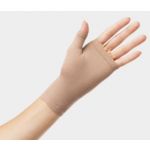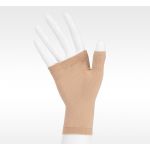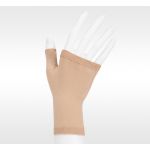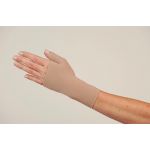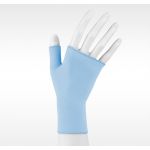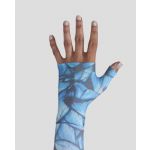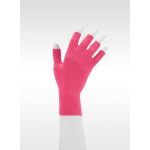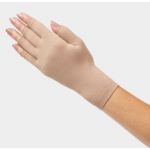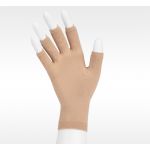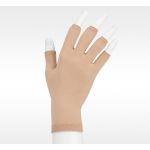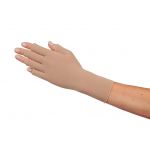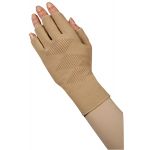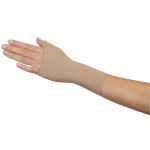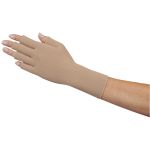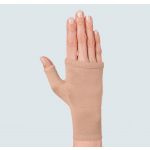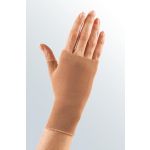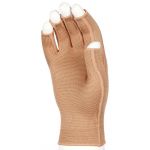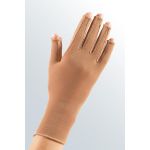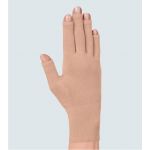Compression Gloves And Gauntlets
Compression Gloves For Lymphedema And Hand Gauntlets
Compression gloves for lymphedema and hand gauntlets are a traditional means of providing compression and support to the hand and fingers in helping to manage and treat upper extremity lymphedema of the hand, but may also be used to treat soft tissue edema and arthritic joint pain.
Shop our compression gloves and gauntlets with pre-tax savings using your FSA or HSA account!
Compression Gloves For Lymphedema And Hand Gauntlets
A lymphedema glove or hand gauntlet is usually worn during the secondary or “maintenance” phase of lymphedema treatment, after completion of complete decongestive therapy (CDT). Compression gloves and gauntlets are made in a variety of sizes and colors, and are specially designed to fit the various anatomical structures of the hand. A compression gauntlet provides gradient compression over the dorsum of the hand, while a lymphedema glove provides extended compression to the fingers. Most manufacturers also offer matching arm sleeves for lymphedema, that can be used along with the compression gauntlet or compression glove to provide complete upper extremity compression for treating lymphedema of the arm.
Compression gloves for lymphedema and hand gauntlets are rated as to the amount of compression they apply, and it is important to choose the correct compression level that is required. Compression is measured in units referred to as millimeters of mercury or “mmHg” and should selected for treatment as follows.
While compression gauntlets and lymphedema gloves may be difficult to don (put on) and take off there are an array of donning and doffing aids which will make it easy to put on and take off compression garments. Also be sure to protect your compression garment investment by using compression garment cleaners and detergents that are specially formulated for compression garments such as compression gloves for lymphedema.
••••••••••••••••••••••••••••••••••••FAQs About Compression Gloves And Gauntlets
Compression gloves and gauntlets are specialized garments designed for managing lymphedema, arthritis, and other medical conditions that affect the hand, wrist, and forearm. Below are some of the most frequently asked questions about compression gloves and gauntlets.
- How Do Compression Gloves And Gauntlets Help With Lymphedema
- What Is The Difference Between A Compression Glove And A Gauntlet
- What Are The Most Common Levels Of Compression In Gloves And Gauntlets
- 15-20 mmHg (mild compression)
- 20-30 mmHg (moderate compression)
- 30-40 mmHg (firm compression)
- What Does mmHg Mean In Compression Gloves And Gauntlets
- How Do I Chose The Right Size And Type Of Compression Glove Or Gauntlet
- Can I Perform Everyday Activities While Wearing Compression Gloves Or A Gauntlet
- How Tight Should My Compression Glove Or Gauntlet Be
- How Long Should I Wear My Compression Glove Or Gauntlet Each Day
- Can I Wear My Compression Glove Or Gauntlet While I Sleep
- How Do I Care For And Clean My Compression Glove Or Gauntlet
- How Often Should I Replace My Compression Gloves Or Gauntlet
- Do I Need A Prescription To Get A Compression Glove Or Gauntlet
- Do Insurance Companies Cover Compression Gloves And Gauntlets
- Does Medicare Cover Compression Gloves And Gauntlets
Compression gloves and gauntlets apply gentle pressure to the hand, fingers, and/or forearm to promote lymph fluid drainage, which can help reduce the swelling and discomfort caused by lymphedema.
A compression glove covers your entire hand, including your fingers. A gauntlet covers your hand, but leaves your fingers free (only providing compression from your wrist to the base of your fingers).
Lymphedema compression gloves and gauntlets are categorized by the amount of pressure they apply to the body, measured in millimeters of mercury (mmHg). The levels of compression can vary in gloves and gauntlets, but the most common ones are:
Millimeters of mercury (mmHg) is a unit of measurement for pressure. For compression gloves and gantlets, mmHg specifies the amount of pressure (tightness) that the glove or gauntlet applies to your hand and wrist. Higher mmHg numbers represent more pressure.
For all of our compression gloves and gauntlets, we have sizing charts from the manufacturer. For most compression gloves and gauntlets, you will take multiple measurements to ensure the correct fit. Your healthcare provider will recommend the compression level.
Most compression gloves and gauntlets are specially designed to allow for normal hand, wrist, and arm movements, which should allow you to do most of your normal activities without restriction.
Your compression glove or gauntlet should be snug, but not painfully tight. The glove or gauntlet should apply steady pressure without restricting or cutting off your circulation.
Your healthcare provider should make specific recommendations. In general, however, lymphedema compression gloves and gauntlets should be worn during waking hours.
Your healthcare provider should make specific recommendations. In general, however, wearing compression gloves or gauntlets while you are sleeping is not recommended. In part, this is because the circulatory dynamics of your body change when you are not moving, and the garments could cause constriction and impede your blood circulation.
If your healthcare provider does recommend compression at night, there are specialized nighttime wear compression garments.
Follow the manufacturer’s specific instructions. In general, however, you should hand wash compression gloves and gauntlets in lukewarm water with mild soap, rinse them thoroughly, and air dry them. It is important to avoid wringing or twisting the gloves and gauntlets (which can stretch or damage the fabric).
Compression gloves and gauntlets lose elasticity (and effectiveness) over time and generally should be replaced every 3-6 months.
No. You can order all of our compression gloves and gauntlets without a prescription. However, we do recommend that you consult a healthcare professional to ensure that you get the recommended garment, if you are unsure as to what you need.
Some insurance plans cover compression gloves and gauntlets, with a prescription. Check with your insurance provider for specifics about your coverage.
Starting in January 2024, thanks to the Lymphedema Treatment Act, Medicare began covering compression products, including compression gloves and gauntlets. The Medicare Part B coverage is limited to: 3 daytime compression garments per affected body part (every 6 months) and 2 nighttime compression garments per affected body part (every 6 months). Click here to read more about the Lymphedema Treatment Act and how to order compression gloves and gauntlets.
Please note that all of the information above is for general informational purposes. Please consult your healthcare provider for specific information and personalized recommendations for your situation.
For more information about our compression gloves and gauntlets, please call (800) 700-1032, or e-mail info@bandagesplus.com.
••••••••••••••••••••••••••••••••••••Medicare Pays For Lymphedema Products
Please note: Thanks to the Lymphedema Treatment Act, which took effect on January 1, 2024, Medicare began to pay for lymphedema products for those who have Medicare B coverage and meet certain other coverage criteria. Please visit our website page covering the details of the Lymphedema Treatment Act to obtain more information about how Medicare pays for lymphedema garments, wraps, and bandages


